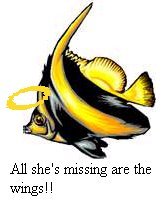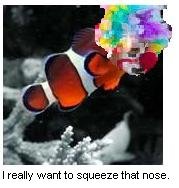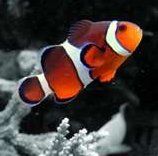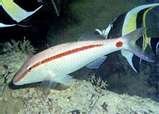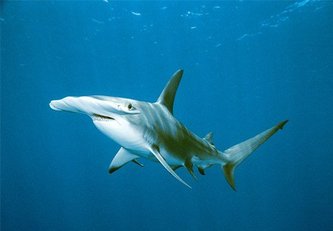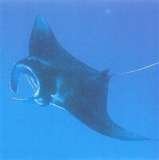WHEREVER THERE IS A ZOO, THERE IS AN OLOGIST!!! da-doo-ch (Luke)
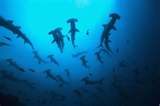
Hrm Hrm.....I am speaking to you today about the importance of some specific sea organisms. Even MORE specific it is about the super amazingness of teenage mutant ninja turtles. Just kidding! I am actually going to talk to you about some specific and interesting creatures of the 'Big Blue'. The Portuguese Man O' War, the Hammerhead Shark, the Anglerfish, and the Seahorse with an awesome 'fishy' picture gallery at the end.
Portuguese Man O’ War
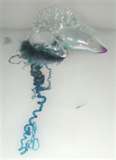
Physical Description:
The Portuguese Man O’ War is referred to by many names: blue bubble, blue bottle, or man-of-war. It is of course, a jellyfish and it is one of the most dangerous in the world. It has an air bladder that allows it to float. It is an invertebrate which means it has no means of holding itself together. This is an odd way of putting it but the Portuguese Man O’ War is actually made up of four kinds of highly modified individuals of polyps and medusoids. Their tentacles can sometimes reach up to 165 feet! Although some have extra long tentacles the average tentacles reach around 30 feet. In fact, some small fish that are almost entirely immune to the poison of the Man O’ War can live among the tentacles. The Man O’ War is infamous for its poison that when a human gets stung they get large, red welts over the stung area and one thing to help it is to put salt water.
Prey:
The Man O’ War will eat pretty much anything: small fish and shrimp along with anything else small that it stings. After it stings its prey it will ‘reel’ it in with contractile cells in the tentacles.
Habitat Description:
The Portuguese Man O’ War floats mainly on the surface of the ocean. Using its main body as a sail the rest of its body just hangs underneath the clear ocean water. It has no means of propulsion but with wind, currents, and tides it flows nicely with the water. It is found in the open ocean in all the worlds’ warm sea. Although, it is mainly found in the subtropical regions of the Pacific and Indian oceans and the northern Atlantic Gulf Stream.
The Portuguese Man O’ War is referred to by many names: blue bubble, blue bottle, or man-of-war. It is of course, a jellyfish and it is one of the most dangerous in the world. It has an air bladder that allows it to float. It is an invertebrate which means it has no means of holding itself together. This is an odd way of putting it but the Portuguese Man O’ War is actually made up of four kinds of highly modified individuals of polyps and medusoids. Their tentacles can sometimes reach up to 165 feet! Although some have extra long tentacles the average tentacles reach around 30 feet. In fact, some small fish that are almost entirely immune to the poison of the Man O’ War can live among the tentacles. The Man O’ War is infamous for its poison that when a human gets stung they get large, red welts over the stung area and one thing to help it is to put salt water.
Prey:
The Man O’ War will eat pretty much anything: small fish and shrimp along with anything else small that it stings. After it stings its prey it will ‘reel’ it in with contractile cells in the tentacles.
Habitat Description:
The Portuguese Man O’ War floats mainly on the surface of the ocean. Using its main body as a sail the rest of its body just hangs underneath the clear ocean water. It has no means of propulsion but with wind, currents, and tides it flows nicely with the water. It is found in the open ocean in all the worlds’ warm sea. Although, it is mainly found in the subtropical regions of the Pacific and Indian oceans and the northern Atlantic Gulf Stream.
Hammerhead Shark
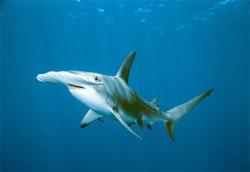
Physical Description:
The Hammerhead shark is the second-best known shark in the world to the one and only Great White Shark. Many people automatically recognize the flattened hammer-like head of this shark. The nine known species of hammerhead they average 3 to 20 feet. The hammer shaped head of this shark provides it with many things: an enhanced ability to find food, aid in close-quarter maneuverability, and allows the shark to make sharp turns without losing stability. Although they are sharks, they have disproportionally small mouths and do a bunch of bottom-feeding. During the day they will hunt in packs of up to 100 but at night, like almost every other shark they become solitary hunters.
Prey:
The hammerhead shark eats many types of fish which would take me forever to name so I’ll just name some of the bigger prey it eats. The sensory nodes on the shark’s body (which are extremely sensitive) can sense the slightest electrical charge in the water, thus sensing stingrays from long distances away. They pin them to the ground with their snouts then take large bites out of their ‘wings’ and wait for them to die then eat them to prevent electrocution.
Habitat Description:
Hammerhead sharks are mainly found in temperate and tropical waters worldwide, near and close to shorelines. They are sometimes seen in mass summer migrations through the clear blue of the world’s tropical oceans.
The Hammerhead shark is the second-best known shark in the world to the one and only Great White Shark. Many people automatically recognize the flattened hammer-like head of this shark. The nine known species of hammerhead they average 3 to 20 feet. The hammer shaped head of this shark provides it with many things: an enhanced ability to find food, aid in close-quarter maneuverability, and allows the shark to make sharp turns without losing stability. Although they are sharks, they have disproportionally small mouths and do a bunch of bottom-feeding. During the day they will hunt in packs of up to 100 but at night, like almost every other shark they become solitary hunters.
Prey:
The hammerhead shark eats many types of fish which would take me forever to name so I’ll just name some of the bigger prey it eats. The sensory nodes on the shark’s body (which are extremely sensitive) can sense the slightest electrical charge in the water, thus sensing stingrays from long distances away. They pin them to the ground with their snouts then take large bites out of their ‘wings’ and wait for them to die then eat them to prevent electrocution.
Habitat Description:
Hammerhead sharks are mainly found in temperate and tropical waters worldwide, near and close to shorelines. They are sometimes seen in mass summer migrations through the clear blue of the world’s tropical oceans.
Anglerfish
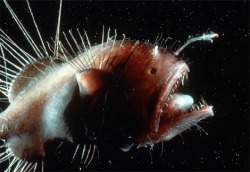
Physical Description:
The anglerfish is one of the oddest creatures out there! They have a bioluminescent spine coming out of its head that it uses to lure unknowing creatures into the range of its sharp teeth. It can also distend its jaw to swallow prey up to swallow prey up to twice its own body size.
Prey:
Anglerfish have a very diverse diet. The females are larger than the males by a long-shot. The females will eat pretty much anything! Squids, turtles, crustaceans, arrow worms, and even some sea birds!
Conservation:
These animals are in some danger because they are constantly hunted for their meat. Their meat is served as a delicacy in Japan. Its liver is a delicacy in Japan worth around $100 U.S dollars. The limiting factors of this creature depend on how much food it can catch over a period of time. There is only so much food in the ocean and they can’t eat the same prey three times.
The anglerfish is one of the oddest creatures out there! They have a bioluminescent spine coming out of its head that it uses to lure unknowing creatures into the range of its sharp teeth. It can also distend its jaw to swallow prey up to swallow prey up to twice its own body size.
Prey:
Anglerfish have a very diverse diet. The females are larger than the males by a long-shot. The females will eat pretty much anything! Squids, turtles, crustaceans, arrow worms, and even some sea birds!
Conservation:
These animals are in some danger because they are constantly hunted for their meat. Their meat is served as a delicacy in Japan. Its liver is a delicacy in Japan worth around $100 U.S dollars. The limiting factors of this creature depend on how much food it can catch over a period of time. There is only so much food in the ocean and they can’t eat the same prey three times.
Seahorses

Physical Description:
The seahorses are extremely unique creatures with their tube-like snouts and curly tails. They ‘stand’ 0.6 to 14 inches tall/long. They swim completely upright which is uncharacteristic for creatures of the ocean. They aren’t very good swimmers with only a dorsal fin to propel them so they mainly grip onto rocks or stationary objects and float there. One odd thing about the male seahorse is that it is the one who carries the babies until they hatch out of their eggs, which isn’t common among ocean dwellers.
Prey:
Seahorses are carnivores (surprisingly) have a very, very, ‘small’ diet. They eat many small things such as shrimp brine, plankton, and other small crustaceans.
Habitat Description:
The seahorse mainly anchors itself in shallower ocean waters around the coast of landmasses, keeping close to the equator. They live in complicated habitats which include things that they can anchor themselves onto and places to hide behind.
The seahorses are extremely unique creatures with their tube-like snouts and curly tails. They ‘stand’ 0.6 to 14 inches tall/long. They swim completely upright which is uncharacteristic for creatures of the ocean. They aren’t very good swimmers with only a dorsal fin to propel them so they mainly grip onto rocks or stationary objects and float there. One odd thing about the male seahorse is that it is the one who carries the babies until they hatch out of their eggs, which isn’t common among ocean dwellers.
Prey:
Seahorses are carnivores (surprisingly) have a very, very, ‘small’ diet. They eat many small things such as shrimp brine, plankton, and other small crustaceans.
Habitat Description:
The seahorse mainly anchors itself in shallower ocean waters around the coast of landmasses, keeping close to the equator. They live in complicated habitats which include things that they can anchor themselves onto and places to hide behind.
'Fishy' Photo Gallery
Sources:
en.wikipedia.org/wiki/Anglerfish
animals.nationalgeographic.com/animals/fish/anglerfish.html
en.wikipedia.org/wiki/Hammerhead_shark
animals.nationalgeographic.com/animals/fish/hammerhead-shark.html
en.wikipedia.org/wiki/Portuguese_Man_o%27_War
animals.nationalgeographic.com/animals/invertebrates/portuguese-man-of-war.html
en.wikipedia.org/wiki/Seahorse
animals.nationalgeographic.com/animals/fish/sea-horse.html

